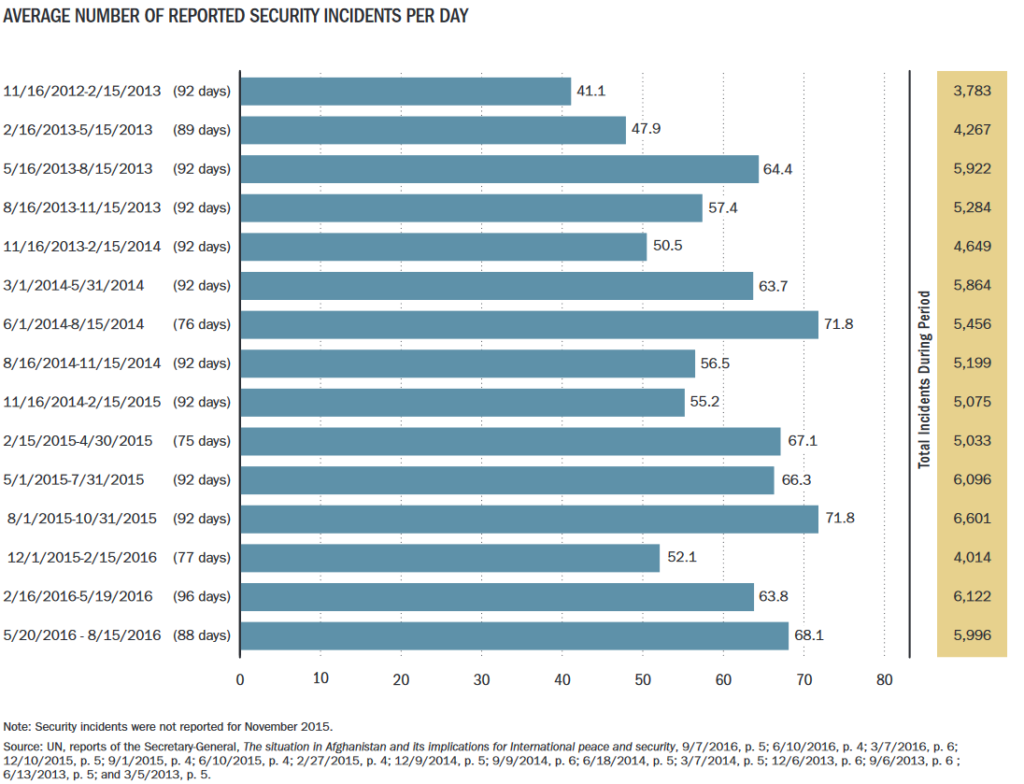The latest quarterly report from the Special Inspector General for Afghanistan Reconstruction (SIGAR) has been released. America’s military involvement in Afghanistan passed its 15th anniversary in October.
The data presented in the SIGAR report show some disturbing trends. Through the first eight months of 2016, Afghan national defense and security forces suffered approximately 15,000 casualties, including 5,523 killed. This from a reported force of 169,229 army and air force personnel (minus civilians) and 148,480 national police, for a total of 317,709. The casualty rate undoubtedly contributed to the net loss of 2,199 personnel from the previous quarter.
 Afghan forces suffered 5,500 killed-in-action and 14,000+ wounded in 2015. They have already incurred that many combat deaths so far in 2016, though the number of wounded is significantly lower than in 2015. The approach of winter will slow combat operations, so the overall number of casualties for the year may not exceed the 2015 total.
Afghan forces suffered 5,500 killed-in-action and 14,000+ wounded in 2015. They have already incurred that many combat deaths so far in 2016, though the number of wounded is significantly lower than in 2015. The approach of winter will slow combat operations, so the overall number of casualties for the year may not exceed the 2015 total.
The rough killed-to-wounded ratio of 3 to 1 for Afghan forces for 2016 is lower than in 2015, and does not compare favorably to rates of 9 to 1 and 13 to 1 for U.S. Army and Marine forces in combat from 2001-2012. This likely reflects a variety of factors, including rudimentary medical care and forces operating in exposed locations. It also suggests that even though the U.S. has launched over 700 air strikes, already more than the 500 carried out in all of 2015, there is still insufficient fire support for Afghan troops in contact
Insurgents are also fighting for control of more of the countryside than in 2015. The Afghan government has lost 2.2% of its territory so far this year. It controls or influences 258 of 407 total districts (63.4%), while insurgents control or influence 33 (8.1%), and 116 are “contested” (28.5%).
 The overall level of violence presents a mixed picture. Security incidents between 20 May 20 and 15 August 2016 represent a 4.7% increase over the same period last year, but a 3.6% decrease from the same period in 2014.
The overall level of violence presents a mixed picture. Security incidents between 20 May 20 and 15 August 2016 represent a 4.7% increase over the same period last year, but a 3.6% decrease from the same period in 2014.
 The next U.S. president will face some difficult policy choices going forward. There are 9,800 U.S. troops slated to remain the country through the end of 2016, as part of an international training and counterterrorism force of 13,000. While the Afghan government resumed secret peace talks with the Taliban insurgents, a political resolution does not appear imminent. There appear to be no appealing strategic options or obvious ways forward for ending involvement in the longest of America’s ongoing wars against violent extremism.
The next U.S. president will face some difficult policy choices going forward. There are 9,800 U.S. troops slated to remain the country through the end of 2016, as part of an international training and counterterrorism force of 13,000. While the Afghan government resumed secret peace talks with the Taliban insurgents, a political resolution does not appear imminent. There appear to be no appealing strategic options or obvious ways forward for ending involvement in the longest of America’s ongoing wars against violent extremism.